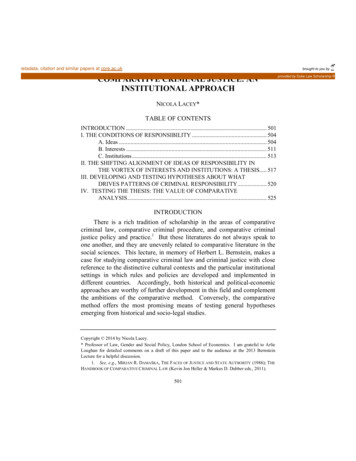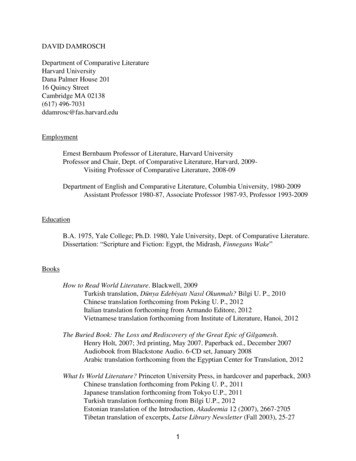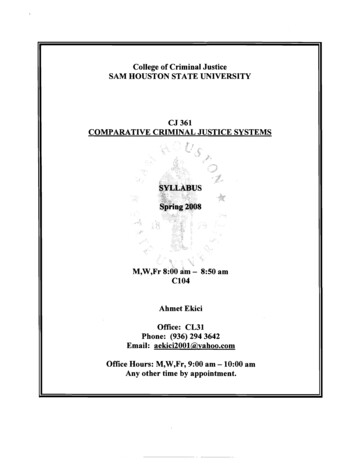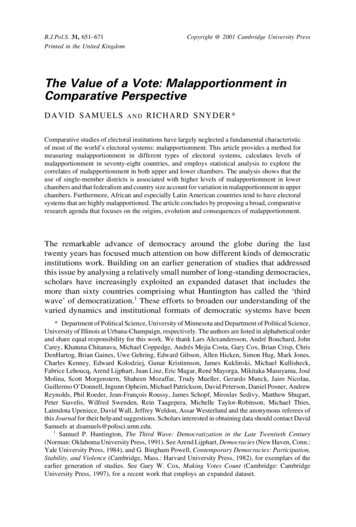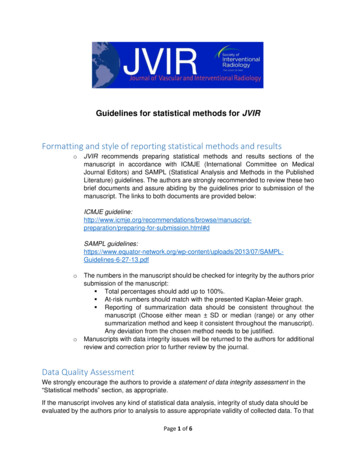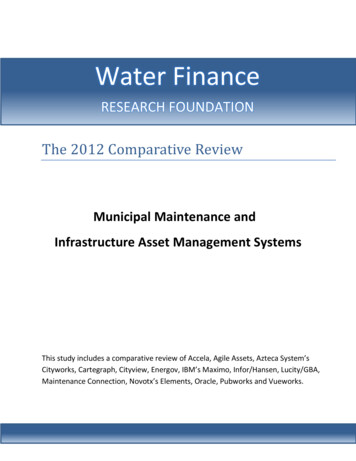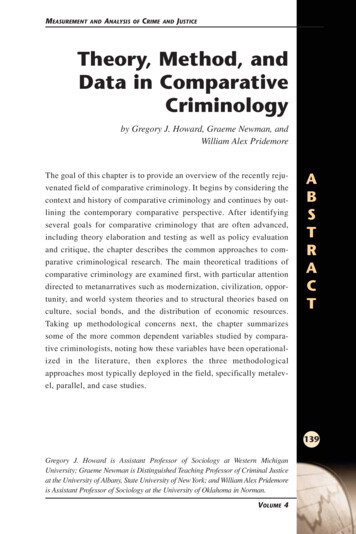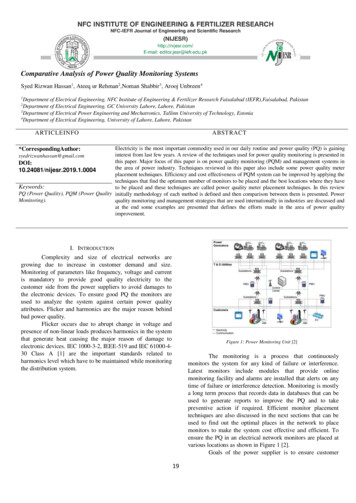
Transcription
INFORMATION AND COMMUNICATION TECHNOLOGIESUDC - 519.72:517.977COMPARATIVE ANALYSIS OF MONITORING SYSTEMS OFCOMPUTER NETWORKHovhannes S. AbgaryanNational Polytechnic University of Armenia105 Teryan St., Yerevan, RAabgaryanhov@gmail.comORCID: 0000-0002-2300-2442Republic of ArmeniaAbstractThe article presents an analysis of the most common monitoring systems for computer networks,as a result of which new criteria for the effectiveness of choosing tools for monitoring computernetworks have been developed, as well as criteria for choosing an effective tool for monitoringcomputer networks.Key words: computer networks, monitoring, diagnostics, analysis, network protocol, control,programming.IntroductionNowadays it is hard to conceptualize an organization operating without computer networks.Companies are constantly dependent on Information Technologies (IT), particularly those oncomputer networks. Currently, it is exceptionally urgent and concurrent to apply network performancemonitoring and diagnostics. As a matter of fact, it will enable network operators to upgrade networkflows.Literary review on the issue and analysisThe issues of computer network monitoring have been addressed by Olifer V.G. [4], WakkeA.D. [2], Wilson Ed. [5], Lavrov A. [3], Tadosyan A. [1] and others [6], [7], [8]. Diverse approachesand methods are presented in their works; however, no comparative analysis is available on thespecific criteria of choosing and outlining appropriate monitoring tools.Research objectives and noveltyThis paper is aimed at devising new criteria for the effectiveness of the selection of computernetwork monitoring tools and conducting comparative analysis according to the devised criteria. Also,efficient tools of the computer network monitoring are advocated based on the activity type.ContentComputer network monitoring is the use of a system that constantly monitors a computernetwork and quickly notifies in case of outages and other problems for further improvement.Computer network management has two stages:1. Monitoring: At this stage a simple operation is performed: the primary data on theoperation of the networks is collected and statistics is made on the condition of all thepersonnel operating in the network, packages of different protocols, tablets, slots, switchesand routers.53
INFORMATION AND COMMUNICATION TECHNOLOGIES2. Analysis: At this stage an analysis is carried out which is a complex and intellectualoperation. Thus, the information collected during the monitoring phase is interpreted,compared with previously obtained data, on the basis of which conclusions are made on thepossible causes of network delays and operation processing failures. Monitoring tasks aredetermined by software and hardware, tests, network analyzers as well as by themanagement agent. The task of analysis requires an active participation of a human factorand the implementation of such complex tools as specialized systems and practicalexperience of network specialists.The divergent tools applied for the analysis and diagnostics of telecommunication networks canbe divided into several major categories:Management system agents - They support one of the standard MIB functions and postinformation via SNMP or CMIP protocols. Receiving data from agents requires control systems thatcollect data automatically.Embedded systems - It is implemented in the form of hardware system with software and isdesigned to perform a diagnostic function. To illustrate, take an example of Ethernet multi-segmentcontrol module.Protocol analyzers - They are software or hardware systems that differ from the control systemin their network flow monitoring and analysis of functions.For cable system diagnostics and certification, devices can be conventionally divided into 4major groups: Network monitors Materials for cable system certifications Cable scanners TestersNetwork analyzers are applied to measure different levels of cable. In addition to the physicallevel, these devices operate at the channel and sometimes network level.Cable system certification instruments carry out certification in accordance with therequirements of one of the international cable system standards.Cable scanners are used to diagnose the cable system.Moving on, now we represent the general characteristics of free and open-source computermonitoring software which are the basis for conducting a comparative analysis of their operation.Zabbix – Open-source monitoring softwareZabbix is an open-source monitoring software tool (Fig. 1). Zabbix consists of Server, Proxy,Agent and Web Interface. Server, Proxy and Agent are written in C. Web Interface is written in PHPand JavaScript.Zabbix offers several monitoring options:Simple checks verify the availability of the host and responsiveness of standard services such asSMTP or HTTP without installing any software on the monitored host.A Zabbix agent is installed on UNIX and Windows hosts to monitor statistics such as CPU load,network utilization, disk space and other information monitoring.External check – monitoring is carried out via SNMP, TCP and ICMP checks.54
INFORMATION AND COMMUNICATION TECHNOLOGIESFig․ 1 ZABBIX monitoring software packageThe following features are characteristic to Zabbix: High productivity and bandwidth, ability of 1000 and more hosts Automatic detection of servers and network instruments through centralized monitoring oflog files, as well as through IPMI, JMX, SSH, Telnet Distributed monitoring with centralized web management Secure user identification Cook book Ability to create a network map Application of such database management systems as MySQL, PostgreSQL, SQLite andOracle for data collection Zabbix server access on Linux, Solaris, HP-UX, AIX, FreeBSD, NetBSD, OpenBSD, Mac OS/ X operating systems; Zabbix Agent Access on Linux, Solaris, HP-UX, AIX, FreeBSD, OpenBSD, OS X, Tru64/ OSF1, Windows 2000, Windows Server 2003, Windows XP, Windows Vista, WindowsServer 2008, Windows 7 operating systems JMX and SNMP v1, 2, 3 support Alerts / warnings via email, SMS and voice signals, Graphic representation of statisticsNagios – Open-source monitoring programNagios is a free and open-source computer-software application that monitors computer systems(Fig. 2). Initially, Nagios has been intended for only being used on Linux operating systems. Then, ithas been implemented on dealing with other operating systems (Sun Solaris, FreeBSD, AIX, and HPUX) [9].Fig․ 2 Nagios monitoring sofware package55
INFORMATION AND COMMUNICATION TECHNOLOGIESThe features of Nagios include: Monitoring of network services (SMTP, HTTP, NNTP, ICMP, SNMP) Monitoring of host resources (processor load, disk usage, system log) in networkoperating systems Remote monitoring supported through SSH or SSL encrypted tunnels. A simple plugin design that allows users to easily develop their own service checksdepending on needs (Fig. 3), by using their tools of choice (shellscripts, C , Perl, Ruby, Python, PHP, C#, etc.) Parallelized service checksFig․ 3 Nagios operation The ability to define network host using 'parent' hosts, allowing the detection of anddistinction between hosts that are down or unreachable Contact notifications when service or host problems occur and get resolved (via email, pager, SMS or any user-defined method through plugin system) Ability to define event handlers to be run during service or host events for proactiveproblem resolution Various software add-ons that provide a general overview of all hosts through whichmonitoring is performed.Cacti - Open-source network monitoring program [11]Cacti is an open-source and web-based network monitoring designed as a front-end applicationfor the open-source, using RRDtool for data collection and graphing (Fig. 4). The program is writtenin PHP and the data is stored in a MySQL database.The features of Cacti include: unlimited graph items built-in SNMP support templates of graphs, hosts and data sources data gathering on a non-standard timespan tree, list and preview views of graph data working with multiple users of their own graphs using additional scripts to monitor any type of data.56
INFORMATION AND COMMUNICATION TECHNOLOGIESFig․ 4 Cacti network graffic monitoring software packageResearch resultsConsidering the mentioned systems and their features, we represent comparative analysis in thissection based on our own criteria (Table 1). Comparative analysis reveals the most effective tool formonitoring computer networks which is applicable by myriad organizations.Comparison of monitoring software packagesCriteriaChartsSLA reportLogical groupingTrendingTrend PredictionAutomatic detectionAgentSNMPSyslogExternal scriptsPluginsDifficulty of creating pluginTriggersWeb accessDistributed monitoringData storage methodLicenseCardsLanguageTable 1Network monitoring softwareZABBIX Easy Full access SQLite, MySQL,PostgreSQL, OracleGNU GPL NAGIOS Via Plugin Via Plugin Via PluginVia Plugin Easy Viewing, reporting, managing Non-dynamic, non-expandabledatabase, SQLGNU GPLDynamic and constructiveC, PHPCCACTI Easy MySQLBSDC, Perl, PHP,PythonConclusionSample and comparative analysis of computer network monitoring software packages has beenrevealed in this research that ZABBIX is more efficient than NAGIOS and CACTI systems. It isworth mentioning that ZABBIX provides support in different operating systems, has a perceptible,57
INFORMATION AND COMMUNICATION TECHNOLOGIESeasy and friendly interface, graphical capability of monitoring data with different parameters,combination of languages and so forth.From now on, the presented comprehensive research enables users to make more conscious andefficient choices according to their own requirements.References1. Tadosyan A.A., Galstyan H.A. Building a school network model in CISCO Packet Trackerenvironment (2017) //Yerevan, 2017, ASPU Scientific Bulletin, No. 4 (33).- p. 47-53․2. Wakke A.D. Zabbix A practical guide (2017) //DMK Press, 2017.- 356 p.3. Lavrov A.A. Monitoring and administration of corporating networks (2013) //Monograph, S.A.Ivanovsky A.A. Lavrov, V.V. Yanovsky, SPb. Publishing house “SPbGETU” LETI”, 2013.- 160 p.4. Olifer V.G., Olifer N.A. New technologies and equipment for IP networks (2000) //SPb.: BHV-SaintPetersburg, 2000.- 512 p.5. Wilson Ed. Monitoring and analysis of networks. Troubleshooting methods (2002) //M:, LORI, 2002.364 p.6. Aftimiei С. Recent evolutions of GridlCE: a monitoring tool for grid systems (2007) //C. Aftimiei, S.An-dreozzi, G. Cuscela, G. Donvito, V. Dudhalkar, S. Fantineli, E. Fattibene, G. Maggi, G. Misurelli,A. Pierro, Proceedings of the 2007 workshop on Grid monitoring, New York, 2007.- p. 1-8.7. Gu J. Efficient Network Monitoring System (2012) //J. Gu, Y. Wu, Z. Gu, Communications inComputer and Information Science, 2012, Vol. 308.- p. 34-40.8. McKellar J. Twisted Network Programming Essentials (2013) //J. McKellar. - O'Reilly Media, 2013.9. Nagios: Nagios Documentation – http://www.nagios.org/ (available 31/03/2021)10. Zabbix: What is Zabbix – http://www.zabbix.com (available 31/03/2021)11. Cati: https://www.cacti.net/documentation.php (available 31/03/2021)References1.Թադևոսյան Ա․ Ա․, Գալստյան Հ․ Ա․ Ուսումնական հաստատության լոկալ ցանցի մոդելի կառուցումCISCO Packet Tracker միջավայրում (2017) //Երևան, 2017թ․,ՀՊՄՀ գիտական տեղեկագիրը, թիվ 4(33).- էջ 47-53։2. Вакке А.Д. Zabbix. Практическое руководство (2017) //ДМК Пресс, 2017.- 356 с.3. Лавров А.А. Мониторинг и администрирование в корпоративных вычислительных сетях (2013)// монография, С.А. Ивановский, А.А. Лавров, В.В. Яновский, СПб.: Изд-во «СПбГЭТУ«ЛЭТИ», 2013.- 160 с.4. Олифер В.Г., Олифер Н.А. Новые технологии и оборудование IP-сетей (2000) //СПб.: БХВСанкт-Петербург, 2000.- 512 с.5. Уилсон Эд. Мониторинг и анализ сетей. Методы выявления неисправностей (2002) //М.: ЛОРИ,2002. - 364 с.6. Aftimiei С. Recent evolutions of GridlCE: a monitoring tool for grid systems (2007) //C. Aftimiei, S.An-dreozzi, G. Cuscela, G. Donvito, V. Dudhalkar, S. Fantineli, E. Fattibene, G. Maggi, G. Misurelli,A. Pierro, Proceedings of the 2007 workshop on Grid monitoring, New York, 2007.- p. 1-8.7. Gu J. Efficient Network Monitoring System (2012) //J. Gu, Y. Wu, Z. Gu, Communications inComputer and Information Science, 2012, Vol. 308.- p. 34-40.8. McKellar J. Twisted Network Programming Essentials (2013) // J. McKellar. - O'Reilly Media, 2013.9. Nagios: Nagios Documentation – http://www.nagios.org/ (հասանելի է 31/03/2021)10. Zabbix: What is Zabbix – http://www.zabbix.com (հասանելի է 31/03/2021)11. Cati։ https://www.cacti.net/documentation.php (հասանելի է 31/03/2021)58
INFORMATION AND COMMUNICATION TECHNOLOGIESՀԱՄԱԿԱՐԳՉԱՅԻՆ ՑԱՆՑԵՐԻ ՄՇՏԱԴԻՏԱՐԿՄԱՆ ՀԱՄԱԿԱՐԳԵՐԻՀԱՄԵՄԱՏԱԿԱՆ ՎԵՐԼՈՒԾՈՒԹՅՈՒՆԸՀ․Ս․ ԱբգարյանՀայաստանի ազգային պոլիտեխնիկական համալսարանՀոդվածում ներկայացված են համակարգչային ցանցերի մշտադիտարկման առավելտարածված համակարգերի վերլուծությունը, որի արդյունքում մշակվել են նաև ովիչափանիշներ և առաջարկներ համակարգչային ցանցերի մշտադիտարկման արդյունավետգործիքակազմ ընտրելու ն, ցանցային արձանագրություն, կառավարում, � АНАЛИЗ СИСТЕМ МОНИТОРИНГАКОМПЬЮТЕРНЫХ СЕТЕЙО.С. АбгарянНациональный политехнический университет АрменииВ статье представлен анализ наиболее распространенных систем мониторингакомпьютерных сетей, в результате которого были разработаны новые критерии эффективностивыбора инструментов мониторинга компьютерных сетей, а также предложена критерии повыбору эффективного инструмента мониторинга компьютерных сетей.Ключевые слова: компьютерные сети, мониторинг, диагностика, анализ, сетевойпротокол, управление, �ել է՝ 01.04.2021թ․Գրախոսման է ուղարկվել՝ 13.04․2021թ․Երաշխավորվել է տպագրության՝ 28․04․2021թ․59
Moving on, now we represent the general characteristics of free and open-source computer monitoring software which are the basis for conducting a comparative analysis of their operation. Zabbix - Open-source monitoring software . Zabbix is an opensource - monitoring software tool (Fig. 1). Zabbix consists of Server, Proxy, Agent and Web .

